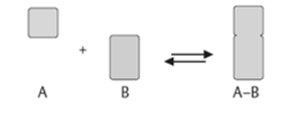|
|
|
|
|
|
|
|
|
Types | Biochemical Property |
Oxidoreductases | The enzyme Oxidoreductase catalyses the oxidation reaction where the electrons tend to travel from one form of a molecule to the other. |
Transferases | The Transferases enzymes help in the transportation of the functional group among acceptors and donors’ molecules. |
Hydrolases | Hydrolases are hydrolytic enzymes, which catalyse the hydrolysis reaction by adding water to cleave the bond and hydrolyse it. |
Lyases | Adds water, carbon dioxide or ammonia across double bonds or eliminate these to create double bonds. |
Isomerases | The Isomerases enzymes catalyse the structural shifts present in a molecule, thus causing the change in the shape of the molecule. |
Ligases | The Ligases enzymes are known to charge the catalysis of a ligation process. |
|
|
|
|
|
- competitive inhibitors are molecules that bind to the same site as the substrate — preventing the substrate from binding to the enzyme active site — but are not changed by the enzyme.
- non-competitive inhibitors are molecules that bind to some other site on the enzyme reducing the power of the catalysis.
|
Catalyst | Enzyme |
Catalyst defined as the molecules that speed up the rate of a reaction without having a change in its structure. | An enzyme is known as a Biological catalyst and globular protein that speed up natural reactions. |
Correlation | |
Could either be enzymes or inorganic salts | Considered as a type of a Catalyst |
Type | |
Mineral ions or small molecules | Globular proteins |
Size Difference | |
Similar in size to the molecule of substrate | Very larger as compared to the substrate molecule |
Molecular Weight | |
The molecular weight is low | The molecular weight of enzymes are high |
Action | |
Normally act on physical reactions | Always act on biochemical Reactions |
Efficiency | |
Work less efficiently | Work highly efficiently |
Specificity | |
Can maximize the rate of various set of reactions | Can only act and increase the rate of a particular reaction |
Regulator Molecules | |
Cannot control the function of inorganic catalysts | Can regregulate the function of enzymes by binding bindingof regulatory molecules with the specific enzyme |
Temperature | |
Not sensitive to small temperature changes, so they work at high temperatures | Temperature specific, so at low temperature, enzymes become inactive, and at high temperature, enzymes get denatured |
pH | |
Not usually sensitive to small changes occurring in pH | Sensitive to small pH changes and operate only at a specific range of pH |
Pressure | |
Work only at high pressure | Work only at normal pressure |
Protein Poisons | |
Protein poisons contain no effect | Can be affected and poisoned by protein poisons |
Short Wave Radiations | |
Contain no effect on the inorganic catalysts | Can have denatured the enzymes |
Examples | |
Iron, platinum, and vanadium oxide | Glucose-6-phosphate, alcohol dehydrogenase, amylase, lipase, and aminotransferase |














